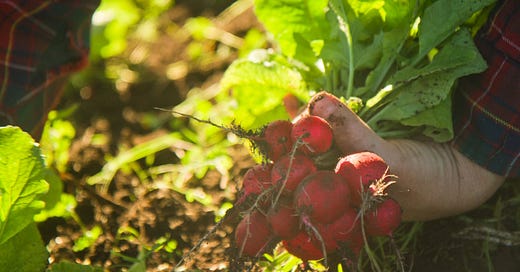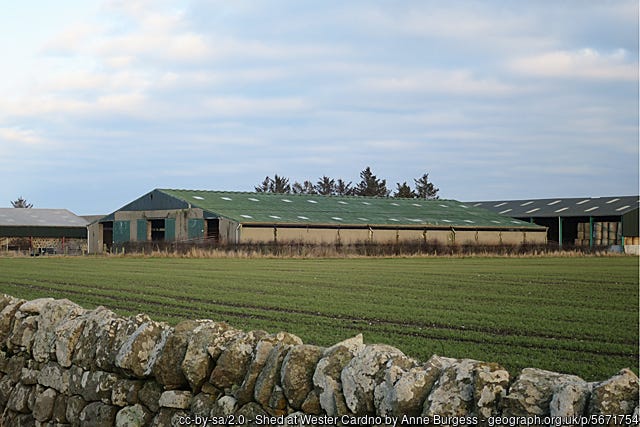In part 1, we looked at the Highland Clearances and the Highland Potato Famine though the lens of my Scottish ancestors. We came to understand the resulting dispossession and displacement of the population as acts of colonization. You can read part one here.
In part 2, we learned that the resulting emigration was a driver of the colonization of the western United States, including my home of Whidbey Island, with the predominant resulting land use being the family farm. We learned too that many of those family farms are struggling for survival with succession and other issues. You can read part two here.
Landed
Traveling the 4000 miles back to Wester Cardno, we find that it too is now a family farm, specializing in beef cattle.
What does it mean to say that “The family farm is a colonial concept”?
Col Gordon’s family farm, Inchindown, is fifty miles west of Wester Cardno and shares a similar history. In the podcast series Landed, hat tip
for the recommendation, we learn that:Col Gordon is a farmer’s son from the Scottish Highlands. After a decade away, he’s finally returned to the place that he loves: his family farm. Now, he’s eager to start realizing his vision for an agroecological future: a future in which rural areas are alive with culture, many more people work on the land, farms operate in sympathy with nature, and nutritious food is available to everyone in society.
Col finds that family farms in Scotland, like those on Whidbey Island, are facing headwinds of aging farmers with no successors and pressure to sell for development or consolidation.
As he wrangles with all of this, Col stumbles across something that throws his vision – and his very understanding of farming – into doubt. What does it mean to say that “The family farm is a colonial concept”? And might this jarring idea be the key to understanding the problem – as well as its potential solutions?
Feedback loop
Col discovers that the colonization of the Highlands and of the Americas were part of the same giant feedback loop, with Scots as both victims and perpetrators of colonial practices.
Displaced Scots were well represented among the enslavers and plantation managers in the British Caribbean. Following the abolition of slavery in the British colonies in 1833, former enslavers were paid £20 million in compensation. Some of that money was used to purchase land in Scotland, in turn dispossessing and displacing more Scots, who in turn participated in the genocide of Native Americans. Profits from the plantations were used to found schools and universities and pay for infrastructure throughout Scotland.
Family farms in both Scotland and the western US owe their existence to acts of colonization in both countries and elsewhere. Reckoning with that history is essential to understanding the challenges they face and to charting a path forward.
Sheep and cows
It seems that wherever we find colonial land theft, animals are either right there, or not far behind.
We’re by no means the first generation of humans to push animal agriculture beyond the carrying capacity of the land. In a recent visit to Dartmoor in England, we saw bronze age stone hut circles. Dartmoor used to be forested. 3500 years ago, people cleared the forest to grow crops and graze animals. As they depleted the soil, they cut more trees. Eventually, they had depleted all the soil and cut all the trees, and the forest became the moor it is today. The people moved on, leaving behind just their hut circles. Like the rubble piles from destroyed crofts in Scotland, a testament to the victory of sheep over people. Sheep, which along with the ponies, still graze there today.
It would be great to say we’ve learned from past mistakes, but a quick look around will confirm that we haven’t. Sugar cane and pineapples in Hawaii have given way to cattle, the continuing water demand contributing to the drying of former wetlands around Lahaina. In Brazil, we’re seeing animal agriculture driving deforestation and colonization of the Amazon, with the resulting dispossession of the indigenous population.
Native Americans in the Pacific Northwest rely on healthy salmon populations also put at risk by animal agriculture as I wrote about here:
Animal agriculture is the main driver of environmental degradation in rural America, which continues to disproportionately affect Native American communities. I wrote about that here:
Back-to-the-land movement
In the 1970s, Whidbey Island was a center of the back-to-the-land movement. With the counterculture well represented, people came where land was cheap to live simply and grow food. Influenced by writers such as Thoreau, and certainly the west’s recent history of homesteading and the myth of rugged individualism, there was an emphasis on self-sufficiency, with the family homestead predominating over community living.
The founding of The Organic Farm School in 2009 has brought a new generation of farmers to the island. While some graduates are doing well, others have struggled with lack of access to land, markets, affordable housing, and community.
You might recognize these as similar to the pressures that caused my ancestors to leave the land and seek their fortune elsewhere. Helping these fledgling farmers fly is the school’s next big challenge.
That’s not my people’s way
Earlier this year, I was invited to present at a conference on Whidbey’s Water Future and to join a panel discussion at the end. I was flanked by a new generation farmer, who spoke about stewarding his 20 acres, and a nationally recognized permaculture expert, who talked about rain barrels and water self-sufficiency on a homestead.
Our keynote speaker, Pamela čəlalakəm SeaMonster, vice-chair of the Snohomish Tribe and a food sovereignty advocate, responded: “You all are talking about individual solutions. That’s not my people’s way. Where’s your community?”
Where’s your community? Where indeed? In the next post in this series, we’re going to go looking for it.
Thanks as always for reading! Shares, likes, comments, and restacks are always welcome!











Lovely and heartfelt post. Thank you for bringing all of this together. 🧡
I can't remember if this was in that Farmerama series or not, but I heard that the compensation the British government paid to slave owners when it was made illegal in the UK is still something that the British taxpayer is covering to this day?
Very much looking forward to reading this - just my sort of thing! Many thanks.